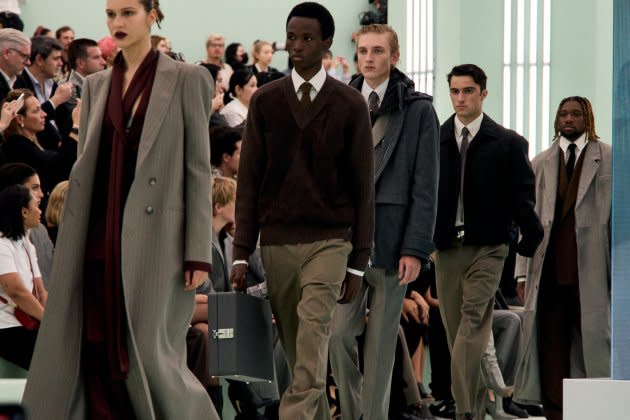Hugo Boss’ Double-digit Growth Continues in Q3

Hugo Boss continued to buck sector trends with its third-quarter results, reporting that revenues had increased 15 percent to 1.03 billion euros.
Even as consumers have become increasingly cautious about discretionary spending on apparel, Hugo Boss notched up the strongest third quarter in the company’s history, the company’s chief financial officer Yves Mueller said.
More from WWD
Birkenstock Still Slides, DVF's Ginger Fix, Boosting South Asian Art
Anita Chhiba, Boss Spotlight the Work of 13 South Asian Artists During Frieze Week
“Given the current difficult economic environment, this is not something we took for granted,” Mueller told journalists at a teleconference Thursday morning. “Despite the weak consumer climate in many parts of the world, we have been able to continue to grow significantly and gain market share.”
In a statement, Hugo Boss chief executive officer Daniel Grieder explained that growth was being driven by “brand, product, and distribution initiatives.” He credited strong brand momentum fueled by star-studded marketing campaigns and high-profile fashion events as the brand transforms itself from a men’s formalwear specialist to a 24/7 lifestyle house.
The results were in line with market expectations.
Boss menswear, the brand’s more formal line and its mainstay, grew 12 percent, currency adjusted, to bring the company 786 million euros over July, August and September. Boss womenswear advanced 24 percent to 73 million euros.
“Womenswear makes about 10 percent of our total business,” Mueller said. “It’s been growing dynamically, so we’re very happy about that.”
Hugo Boss’ more casual Hugo line grew 25 percent to 169 million euros.
The move toward the 24/7 lifestyle image was working well, Mueller said. Investments in product quality and marketing was being well received at retail. Additionally, Hugo Boss’ celebrity-spangled social media was attracting a lot more younger customers, the executive added.

This also meant that Hugo Boss’ operating expenses had continued to increase, rising 9 percent to 510 million this year.
Europe, the Middle East and Africa remains the brand’s biggest market, with sales there increasing 12 percent, currency adjusted, to 653 million euros. The warmer weather in Europe was having some impact though as customers were not spending on winter clothing quite yet, Mueller explained.
The German brand has been focused on making inroads into the U.S. and third-quarter sales in the Americas rose 22 percent. Its repositioning, which has included sportswear collaborations with national basketball and football associations, was clearly bearing fruit, he said, and “we have significantly increased our fan base across American society.”
Third-quarter tallies also increased 21 percent in Asia-Pacific.
Hugo Boss has also been pushing hard into digital terrain with a revamp of its online offerings. In the quarter, the brand’s digital sales rose 25 percent to 187 million euros. Brick-and-mortar retail in the brand’s own stores rose 8 percent to 521 million euros.
Since the end of the pandemic, many customers have returned to brick-and-mortar stores, Mueller said, but Hugo Boss was still seeing a lot of traffic to its digital flagship. Online sales now make up 19 percent of Hugo Boss’ total sales, he noted.
The company’s earnings before interest and taxes gained 12 percent to hit 103 million euros.
Hugo Boss has a stated ambition of bringing in 5 billion euros annually by 2025. In its statement, the brand cautioned about “ongoing high levels of geopolitical tensions as well as macroeconomic uncertainties, which could weigh on consumer sentiment also going forward.”
However this would not impact the German brand’s 2025 objective, Mueller said, confirming that the company was still on track to achieve this.
Best of WWD
